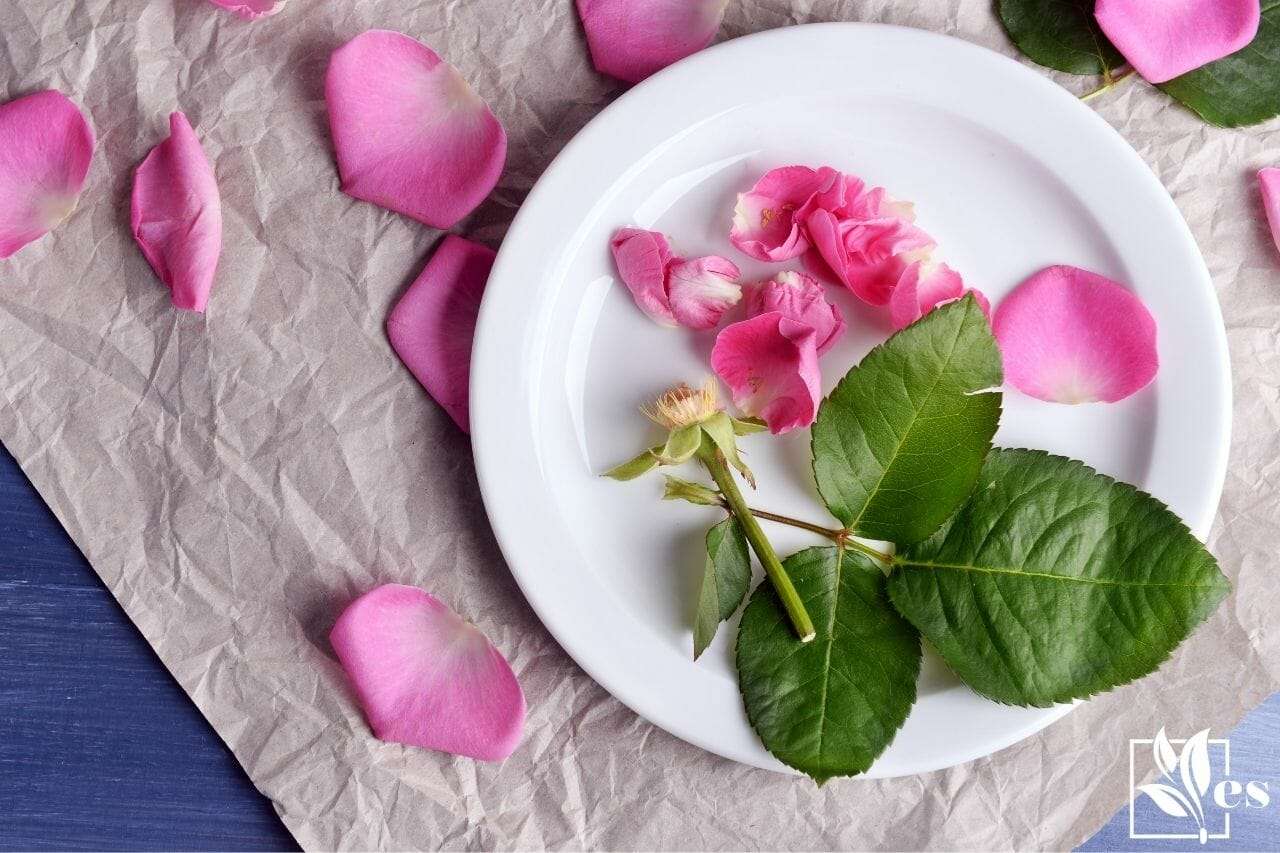- How to Know If Plant Is Overwatered: Key Signs and Remedies - October 11, 2024
- Overwatered Donkey Tail: Tips for Recovery and Care - October 11, 2024
- Underwatered Overwatered Petunias: Identifying and Fixing Common Issues - October 11, 2024
 There are several parts of a rose plant, each with a distinct form and function. Many people only know this Rosaceae family plant by its renowned and luxurious flowers. However, it is much more complex and interesting as a whole.
There are several parts of a rose plant, each with a distinct form and function. Many people only know this Rosaceae family plant by its renowned and luxurious flowers. However, it is much more complex and interesting as a whole.
Learn all about the anatomy of a rose bush plant and its flowers in this article.
JUMP TO TOPIC
What Are the Parts of a Rose Plant
The rose bush plant has been one of the most popular species of flowering plants all over the world for centuries. It is a woody perennial plant that has lived for more than two years. It belongs to the genus Rosa and contains over 300 different species.
The rose bush plants form a diverse group in which some species exist as shrubs while some exist as creepers or climbers. Furthermore, most of them are covered in thorns.
The most exuberant part of the rose bush plant is, of course, the flowers. These can be of various sizes and shapes, but all of them are showy and beautiful. Moreover, a rose plant comprises flowers, stems, and leaves along with an extensive root system. Learn about each of these parts in detail below.
– Parts of a Rose Flower
The rose flower is made up of male and female reproductive parts surrounded by sepals and petals. We’ll be discussing these parts below.
– Stamen: The Male Reproductive Part
The stamen is the male reproductive part within the structure of rose flower. Moreover, this is the part of the rose flower that is responsible for producing pollen.
In the rose plant, multiple stamens are present within a single flower, all of them encircling the single ovary. Most rose types have about five stamens per flower. Some might have more than this, but the total number of stamens in a rose flower is always a multiple of five.
The stamen further comprises two sub-components: the anther and the filament.
– Anther
The anther is a two-lobed sticky structure at the top of the filament. If you look microscopically, then the anther contains four sac-like structures called microsporangia that are actually responsible for producing pollen for the plant. Inside of a rose flower, the anther is usually oval in shape and yellow or orange in color.
– Filament
The filament is the slender park-like component of the stamen that emerges from the base of the flower and terminates in the anther.
– Pistil: The Female Reproductive Part of the Rose
The female reproductive part is called the pistil and is located in the center of a rose flower. It consists of three parts that are collectively known as the carpel.
Below, we will discuss these three parts in detail.
– Ovary
The ovary is the rounded thick part at the base of the pistil. This structure produces and stores the female eggs called the ovules. Furthermore, in the rose plant, each ovary produces a single dry seed called achene.
– Style
The style is the long, tube-like structure emerging from the ovary and ending in the stigma.
This slender part is essential for pollination because this is where the pollen tube essentially forms in the beginning. The style is also responsible for filtering the pollen that passes through it to the ovary. All incompatible pollen gets caught up in its tube and is not allowed to pass through.
– Stigma
The stigma is the rounded top portion of the female reproductive part of the flower. It is sticky to touch as this is the structure that attracts and catches the pollen, allowing them entry into the ovary.
– Petal of the Rose Flower
Petals are actually modified leaves that surround the reproductive organs of the flower. They are brightly colored in order to attract pollinators to the flower. All the petals in a flower are known collectively as the corolla.
Now, as everyone knows, the rose flower petals are known the world over for their vibrant colors. Most species of roses have five petals in their flowers. However, some even have four or six petals, and each petal is divided into two equal lobes. This part of the rose is more susceptible to wilting.
– Sepals of the Rose Flower
Sepals too are modified leaves that are rather smaller in size and surround the petals of the flowers. Before the rose flower blooms, the sepals are responsible for protecting the flower buds due to their tough structure.
Even after it blooms, the rose flower sepals carry on their task of protecting the bloomed flower. All the sepals of a flower are collectively known as the calyx. They are green in color, contain chlorophyll, and carry out photosynthesis just like unmodified leaves.
Almost all rose flowers have five sepals surrounding them. One exception is the rosa sericea flowers which have only four sepals.
– Parts of a Rose Bush
Find out all about the different parts that make up the rose bush plant here.
– Stem
The stems of rose bushes are slender, woody, and covered in sharp thorns. In color, they vary from a bright dark green to dark red. The lengths of the rose bush stems vary from one plant class to the next. Rose stems can be affected by overwatering, so be extra careful.
– Functions of the Stem
The stem of a plant performs several important functions. Read below to find out what they are.
Stems are responsible for transporting water from the roots of the plant to the upper structures like the leaves and the flowers. They also transport food produced by the leaves to the rest of the plant. Stems act as storage organs for food as well.
Moreover, stems are the structure that is responsible for the overall growth of the rose bush, elevating the flowers and the leaves. These structures carry out the process of producing new living tissue in the plant.
– Parts of the Stem
The stem has several different parts as well. Read below to learn all about them.
-Peduncle
The peduncle is the part of the stem that connects it with the flower. It is softer than the rest of the stem, often green in color and doesn’t have any thorns on its surface. The main function of a stem peduncle is to provide support to the plant inflorescence.
– Bract
The bract is a tiny life-like structure at the bottom of the stem peduncle. Bracts are tough structures and their main function is to protect the rose bush plant from insect attacks and damages incurred from bad weather.
– Leaves
The rose flower leaves are compound, meaning they are made up of several smaller leaflets. As the plant ages, the leaves also grow in size through the addition of more leaflets to it.
A several-year-old leaf might have seven or nine leaflets, each attached to one another via a tiny stem called the petiole. The top leaflet of the leaf is called the terminal leaflet.
In a rose bush plant, the leaves are present alternatively on the stem, and they have a serrated margin in most species. Most of the time, the leaves of the rose bush plant have an average length of around two to six inches.
– Thorns
Thorns or prickles on the rose bush are sharp projections on the surface of the stem. Unlike true thorns which are modified stems, the thorns of the rose bush are simply epidermal outgrowth.
These thorns are usually sickle-shaped and their amount depends on the type of the plant. Some rose types are dense with thorns while others only have a scarce amount of them.
– Roots
The rose bush plant has a complex root system consisting of both primary and secondary roots. These roots enlarge and become woodier as time progresses and the plant grows older.
– Primary Roots
The primary roots of the rose bush plant are large, thick and responsible for stabilizing the entire plant in the soil. They also store a large number of nutrients for the plant to use in times of need.
– Secondary Roots

The primary roots of the rose bush plants branch into secondary feeder roots that become smaller and smaller in size as they branch off.
These feeder roots are covered in minuscule hair-like structures that are responsible for the absorption of nutrients into the roots from the soil.
Final note:
The rose bush plant has an extensive root system that spreads far and deep underground, and these roots can grow about four feet deep and three feet wide in an adult plant. That is why removing and getting rid of the rose bush plant from a lawn can be a real hazard.








